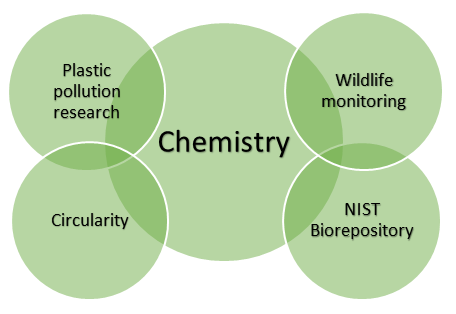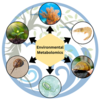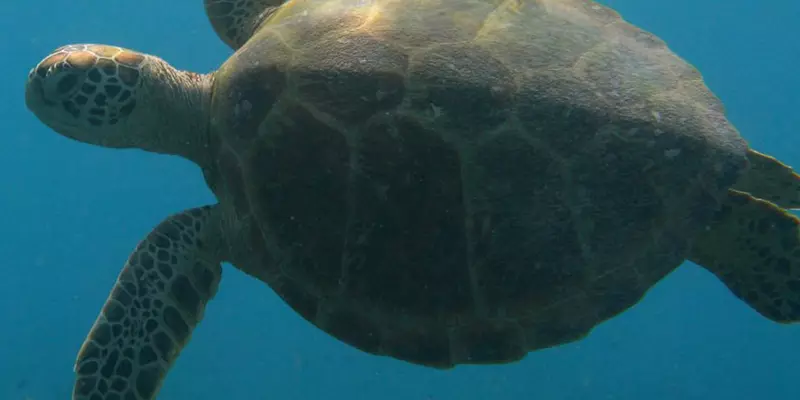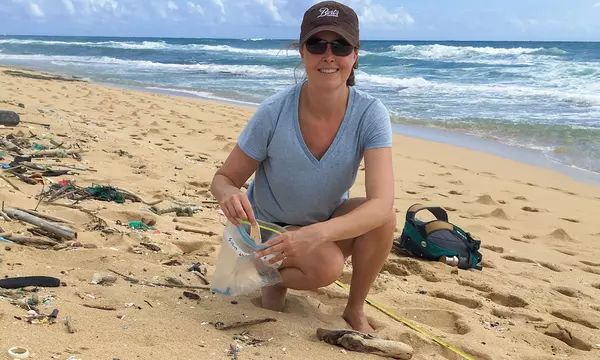NIST supports assessments of the marine environment with measurement science, reference materials and data, and we contribute to the development of standards for sample collection and analysis.
NIST's programs in marine science are supported by our deep expertise in chemistry. We develop measurement science and produce reference materials to aid detection of environmental contaminants and evaluation of biomarkers of the health of marine wildlife, providing technical advice to government agencies like the National Oceanic and Atmospheric Administration and the Environmental Protection Agency. We work with multiple agencies and institutes to collect environmental and biological samples that are preserved as a research resource in the NIST Biorepository.

More recently, we have turned our chemistry prowess to the problem of plastic pollution (learn more below), and support for the development of a circular economy, in which plastics and other materials are engineered to stay in the economy as recycled or upcycled products, preventing them from becoming marine debris.
Our staff members work at the NIST campus in Gaithersburg, Maryland, the Hollings Marine Laboratory in Charleston, South Carolina and at Hawaiʻi Pacific University in Waimānalo, Hawaiʻi.
Learn More
Chemical contaminants and trace elements - NIST has a long history of developing measurement methods to support the detection and monitoring of heavy metals and other elements in the environment, and in animal and human tissues, blood and urine. Our reference materials—products that we have tested rigorously and for which we share results and data—are used by labs all over the world for ensuring that their measurement equipment and methods are working properly. When test methods are considered reliable, results from various labs can be compared confidently and researchers can build on each others' work.
Wildlife health monitoring - NIST's analytical chemistry experts are known the world over for their scientific rigor and innovative problem solving. We share that expertise with other government agencies, providing measurement expertise that they may not have in-house.
- The NIST Biorepository at the Hollings Marine Lab has maintained environmental and biological samples for over 40 years that enable retrospective monitoring of environmental and human health by government agencies and other researchers.
- NIST has been a long-time partner with the National Oceanic and Atmospheric Administration in assessing marine mammals for signs of stressors in their environment through the Marine Mammal Tissue Bank, which was formally established by the Marine Mammal Health and Stranding Response Act (Public Law 102-587) in 1992.
- NIST established collection protocols, analyzes samples, and has developed new methods for non-invasive sampling and assessment of pollutants.
- We have partnered similarly with the U.S. Fish and Wildlife Service and Geological Survey to monitor contaminants in Alaska's marine environments through tissue samples from seabirds.
- In 2010, Congress directed NIST to expand this and other programs into the U.S. Pacific Islands. That expansion led to NIST's partnership with Hawaiʻi Pacific University to monitor plastic pollution.
Plastic pollution research - Members of industry, universities, and government agencies here and abroad look to NIST to develop standards and methods for measuring amounts and types of plastic pollution ranging from mega-sized fishing gear to nano-sized particles. Through chemical testing, sources of the pollution may be deduced—opening possible solutions to reverse this environmental problem.
- NIST partnered with Hawaiʻi Pacific University to establish the Center for Marine Debris Research. The partnership has published 22 scientific papers on plastic marine debris, graduated 10 masters students, and co-hosted the 2019 Hawaiʻi Marine Debris Action Plan Research Workshop with NOAA’s Marine Debris Program.
- NIST holds the largest representation on the Informal U.S. Government Nanoplastics Interest Group, which is coordinated by the U.S. Food and Drug Administration with support from the National Nanotechnology Coordination Office. Nanoplastics, sub-microscopic particles expected to be wide-spread in the environment and capable of transporting chemicals throughout the body, are a public health concern. NIST, because of its unique capabilities and expertise, is a leader in developing innovative measurement methods to detect, quantify and characterize nanoplastic pollution.
- NIST co-chairs the intergovernmental North Pacific Marine Science Organization’s Working Group 42, charged with defining the best methods for monitoring plastic pollution in the most plastic polluted ocean basin.
- NIST and the Center for Marine Debris Research partnered with the American Chemistry Council to produce a polymer kit of 22 plastic polymers typically found in the environment, a critical tool for microplastic research.
In addition, NIST optical experts provide measurements and standards for calibration of instruments used for satellite monitoring of Earth's oceans.













